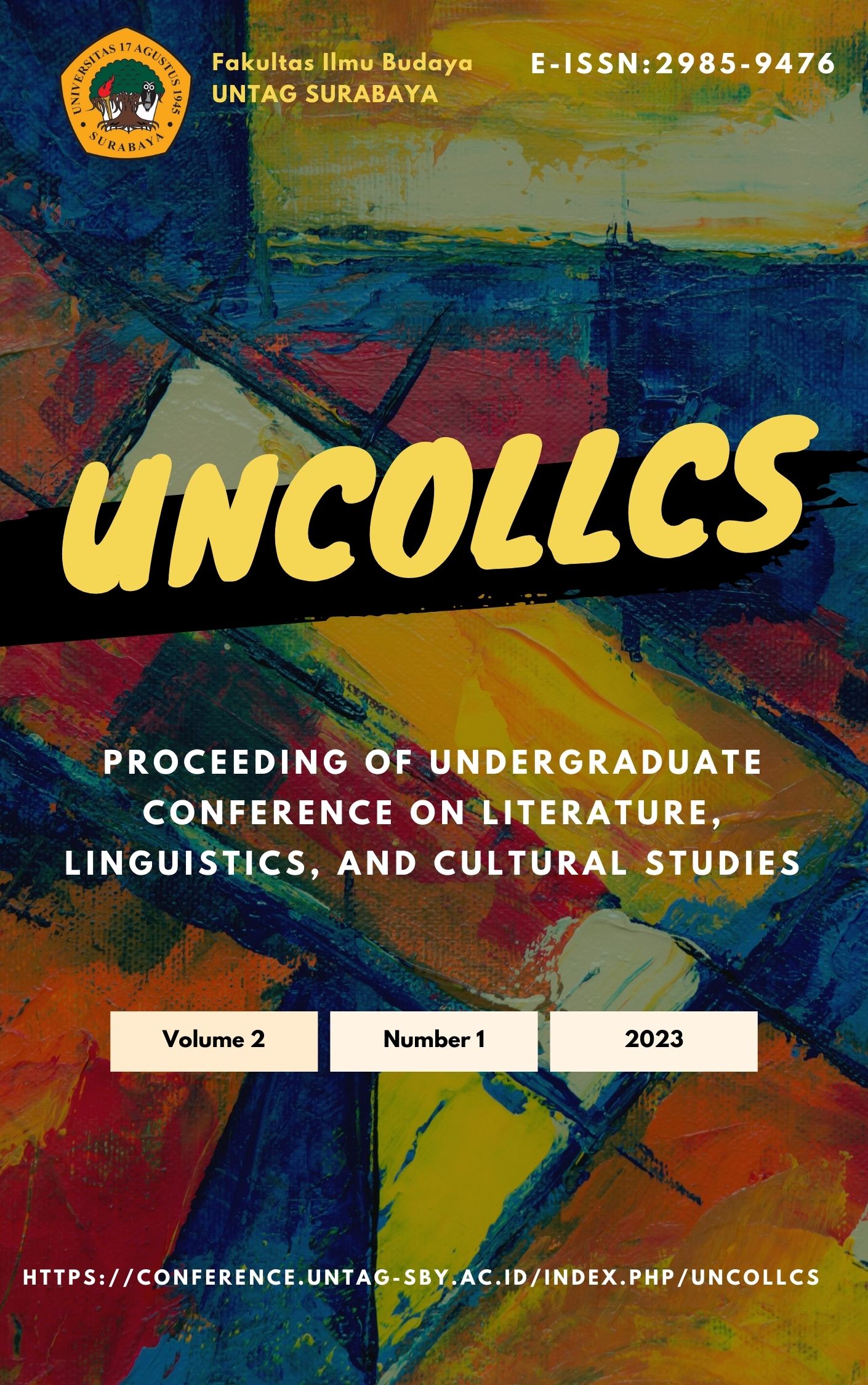Laura's Post-Traumatic Stress Disorder in Ruth Wares' The Woman in Cabin 10
DOI:
https://doi.org/10.30996/uncollcs.v2i1.2488Abstract
This study will examine four issues: Laura's PTSD symptoms, PTSD causes, PTSD effects, and the defense mechanisms Laura employs to manage her PTSD. This study uses a literary psychology approach with PTSD concept theory by Rogers & Liness of the National Institute of Mental Health and and defense mechanism theory which will focus on how Laura defends herself in dealing with PTSD. This study uses a qualitative research method. The source of the data is Ruth Wares’ The Woman in Cabin 10. The writer uses data collection techniques by reading the whole novel, identifying, collecting, classifying and analyzing data. Based on the analysis, Laura experiences four symptoms: re-experiencing, avoidance, arousal and reactivity, and cognition and mood. Laura has PTSD due to a break-in at her flat that left serious scars on her face after a burglar tried to lock her in a room and she spent two hours trying to escape and call for help. These events affect aggression, panic attacks, insomnia, claustrophobia, hallucinations, illusions, and horrific imaginations. Laura uses Defense Mechanism as a self-esteem boost to protect herself from disturbing feelings and thoughts that she cannot handle. From the data, Laura uses several defense mechanisms such as repression, denial, rationalization, sublimation, projection, reaction formation, and displacement. Repression and rationalization are the defense mechanisms that Laura uses the most. Laura uses repression to put her anxiety due to PTSD into her subconscious and forget about it so that it does not interfere with her daily life. Laura uses rationalizations to justify her feelings and actions to attain comfort and ego satisfaction.
References
Aras, G. (2015). Personality and Individual Differences : Literature in Psychology- Psychology in Literature. Procedia - Social and Behavioral Sciences, 185, 250–257. https://doi.org/10.1016/j.sbspro.2015.03.452
Atieno, O. P. (2009). AN ANALYSIS OF THE STRENGTHS AND LIMITATION OF QUALITATIVE AND QUANTITATIVE RESEARCH PARADIGMS. 13, 13–18.
Corey, G. (2009). Theory and Practice of Counseling and Psychotherapy 8th. Belmont: Thomson Books, 64.
Dogra, N., & Cooper, S. (2017). Defining mental health and mental illness. Psychiatry by Ten Teachers, Second Edition, May, 1–11. https://doi.org/10.1201/9781315380612
Fadilla, M. (2020). Post-Traumatic Stress Disorder Found In Gillian Flynn’s Sharp Objects. In Undergraduated Thesis. University of 17 Agustus 1945.
Hamblen, J., & Barnett, E. (2018). PTSD: National Center for PTSD. Behavioral Medicine, 366–367.
Nurhadi, M. (2019). TRAUMATIC NEUROSIS OF WAR IN COLLIN’S MOCKINGJAY. Anaphora : Journal of Language, Literary, and Cultural Studies, 2(1), 49-55. https://doi.org/10.30996/anaphora.v2i1.2741
Mesang, Y., & Rahayu, A. (2022). Billy Pilgrim’s Traumatic Symptoms and Triggers in Kurt Vonnegut’s Slaughterhouse-Five. Anaphora : Journal of Language, Literary, and Cultural Studies, 5(2), 201-213. https://doi.org/10.30996/anaphora.v5i2.7512
Pratiwi, A. (2022). Alicia Berenson’s Complex Post-Traumatic Stress Disorder in Alex Michaelides’ The Silent Patient. University of 17 Agustus 1945.
Pratiwi, A., & Pramesti, T. (2022). Alicia Berenson’s complex post-traumatic stress disorder in Alex Michaelides’ the silent patient. Austronesian: Journal of Language Science & Literature, 1(3), 131-140. https://doi.org/10.59011/austronesian.1.3.2022.131-140
Rogers, P., & Liness, S. (2000). Post-traumatic stress disorder. Nursing Standard (Royal College of Nursing (Great Britain) : 1987), 14(22). https://doi.org/10.7748/ns2000.02.14.22.47.c2763
Sadock, B. J., & Sadock, V. A. (2010). Kaplan & Sadock’s Concise textbook of Clinical Psychiatry. 2th Edition. Jakarta : ECG.
Snowden, R. (2006). Freud. London: Hodder Education.
Spielman, R. (2002). Book Reconsidered. The Ego and the Mechanisms of Defence, 36(3), 430–434. https://doi.org/10.1046/j.1440-1614.2001.01067.x
Ware, R. (2016). The Woman in Cabin 10 (Reprint (ed.). Scout Press.
Downloads
Published
How to Cite
Issue
Section
License
Copyright (c) 2023 Proceeding of Undergraduate Conference on Literature, Linguistic, and Cultural Studies

This work is licensed under a Creative Commons Attribution-NonCommercial-ShareAlike 4.0 International License.










